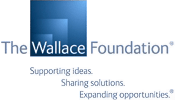I was struck by Eric's desire to see real change happen in
his/our lifetime. If there's a lesson to learn about our K-12 work, I think the
lesson is that the work is long-term. There's no magic bullet. The education
field is littered with school reform interventions, large and small, smart and
dumb, often disconnected from where the real work takes place, with teachers
and students, as Jane pointed out earlier. If you want to read more about that, I would suggest picking up Left Back, A Century of Battles over School
Reform, by my friend, Diane Ravitch.
In the early to mid-90s, Rob Horowitz, Mitchell Korn, and I
authored a plan to create The Center for Arts Education in New York City,
securing what would initially become a five-year grant of $36 million in
funding from The Annenberg Foundation, government, and private funders to
revitalize arts education in the New York City public schools. It was part of
the Annenberg Challenge and was created by a large scale, community-based
planning project that believe it or not included over 100 people providing
feedback to 10 drafts. The research for this project covered virtually every
aspect of arts and education imaginable in New York City and beyond. The project was then led by Hollis Headrick, Laurie Tisch, and Greg McCaslin.
There have been considerable successes, including the
creation of categorical, per-capita funding averaging $65 per student,
restricted to spending on arts education (this fund reached a level of $75
million per year, at a time when the entire NEA budget was $99 million); the
hiring of well over 600 certified arts specialists; major media attention (NY
Times front page, editorial page, and more); the creation of a senior arts
education position and office at the Board of Education, that eventually grew to
over eight full-time staff members; a public private/partnership that included
city government, the Board of Education, and the local teachers union,
supported by civic and business leadership throughout the city; the building of
over 130 innovative whole school arts education partnerships with hundreds of cultural
and community-based organizations, and post secondary institutions, bringing
arts education to every students in those partnership schools; and a public
refocusing on arts education in New York City as never seen before or since.
While arts education in New York City has certainly
advanced, the work of CAE never went to the scale intended: providing access
and quality arts for all children. There are now almost 1500 schools in the
system! Among the many successes, there were misses, particularly in the areas
of sustained advocacy, and in moving arts education into the educational
mainstream. In addition, it appears, according the NYCDOE studies that we are
losing ground in a number of key areas, and as a local community may not be
well prepared to deal with the economic downturn. And, the categorical funding,
which had leveled off at a mere $67 million per year, has been eliminated (to
support empowering principals).
As we passed the mid-way point in this online discussion, I
want to express my belief that our work is evergreen. The success of CAE in the
90s, resembles in many ways the success of Big Thought today. The arts
curricula of today, some of which appears so innovative and important, are only
an iteration of the many arts frameworks and curricula of the past 40 years. The
much talked about report by RAND, only echoes the early reports like Coming to Our Senses. The teaching
artists of today were pioneered by the Ford Foundation sending composers into
schools for three-year residencies in school systems as early as 1962. The
national commitment of The Wallace Foundation is echoed by the commitment of The
Annenberg Foundation, which is echoed by an earlier arts education effort by the
very same The Wallace Foundation, which is echoed by the truly groundbreaking
philanthropy of The JDR 3rd Fund beginning in 1967.
We are building, or attempting to build a new house,
brick-by-brick, as the shape of the bricks change, as the design of the
blueprints change, as earlier bricks erode, all in ways that we can not
necessarily predict, making sustainability difficult at best, illusory at
worst.
The work is evergreen.

4 Comments
Leave a comment